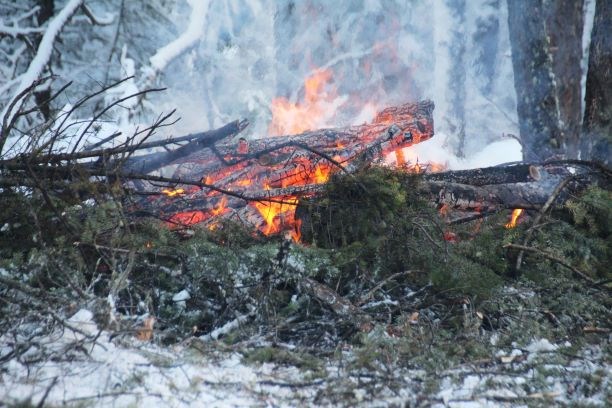
Joanne McQuarrie, Local Journalism Initiative Reporter | [email protected]
Wildfires may not be on your mind as you trudge through snow at this time of the year.
But with the official start of wildfire season on March 1, and the ongoing goal of mitigating negative effects of the mountain pine beetle on forests, Parks Canada and the Municipality of Jasper are getting ready.
In October 2020, Seamus O'Regan, federal minister of Natural Resources, announced funding of $68.4 million over three years to help control, research and mitigate the impacts of the mountain pine beetle on Canada's forests.
The funding includes $60 million to the Alberta government for forest management and research; $6.9 million to Parks Canada to mitigate mountain pine beetle impacts, including wildfire risks in the Rocky Mountain National Parks; and $1.5 million to Natural Resources Canada to enhance its core research program.
“The majority of the $6.9 million came to Jasper for the Firesmart (program) and the hazard tree removal in Wapiti and Wabasso (campsites),” said Steve Young, spokesperson for Jasper National Park, in an email.
Parks Canada moved forward with projects in Jasper National Park where the impacts of the mountain pine beetle are most significant. The majority of work has been associated with minimizing wildfire risk caused by the mountain pine beetle.
Parks Canada and the municipality conducted community protection and wildfire prevention work in areas surrounding Jasper. Trees killed by mountain pine beetles are being removed in the temporarily-closed Wapiti and Wabasso campgrounds. Removing dead trees in mountain pine beetle-affected forests reduces the risk of trees falling, the amount of fuel surrounding campsites and the risk of wildfire spread.
Planting replacement trees in areas where trees have been removed for public safety assists with restoring forest habitat in Jasper National Park. Each year, the park transplants thousands of local native trees from FireSmart-maintained areas. Transplanted trees are primarily Douglas fir, which have strong fire-resistant qualities and provide important habitat structures in popular spaces like the park’s campgrounds.
In Jasper National Park, as part of ongoing efforts to reduce the risk of large wildfires around affected communities, Parks Canada will purchase a high volume sprinkler system. Used in strategic locations, such as along the community fireguard in Jasper, this system will enhance community protection, helping ensure the safety of people and critical infrastructure.
“The Municipality of Jasper works very closely (year round) with Parks Canada in wildfire preparedness and mitigation, as well as major emergency planning, evacuation planning as it relates to a wildfire event threatening the community,” said Greg Van Tighem, director of protective services, in an email.
Van Tighem said the municipality has reviewed and/or updated its emergency plans, evacuation plan, emergency social services plan as well as the wildfire preparedness guide and the wildfire tactical response plan.
“The fire department has been upgrading its wildland urban interface fire (WUI) response resources and training over the past few years and over the next two months we will be bringing these resources into service and initiating WUI response training,” he said.
“In early May we will start up our Firesmart Canada Community work bee program once again and will be hosting educational work-bees throughout the community in efforts to assist residents in making their home and property Firesmart.”
With the municipality spending a great deal of time in managing the forest fuels around the community, Van Tighem outlined objectives of the Firesmart forest fuel reduction program:
- Eliminate fast moving crown fire potential close to and surrounding the townsite and critical infrastructure.
- Reduce surface fire intensity by reducing density of young conifer growth, reduction of ladder fuels on residual mature trees.
- Reduce firebrand emission and density of embers transported to residential and commercial areas (the primary cause of structural ignitions).
- Reduce the difficulty of fire suppression and containment near the townsite and reduce potential for direct fire spread into residential area/commercial areas.
- Produce immediate and long-term wildfire hazard reduction from beetle-impacted forests during all stages of attack, stand decomposition and forest regrowth.
- Encourage forest stand conversion to favor mixed-wood, deciduous and open conifer savannah fuel types.
- Complement the efforts of Jasper residents and businesses to reduce wildfire risk in their respective Home Ignition Zones, thereby reducing the risk of wildfire losses.
The municipality allows small recreational fire pits in private residential properties, provided that they are safely contained in a non combustible fire pit and a safe distance away from any other combustibles. However, the municipality may at any time initiate a fire ban, which would prohibit the use of residential fire pits.
“We are currently on track with the current forest fuel reduction program, however the forecast is for continued warmer weather and rain over the weekend which may put the program on hold until we receive more snow cover and colder temperatures,” Van Tighem said.
Van Tighem encourages everyone to adopt Firesmart Canada home-safety guidelines that can be found at firesmartcanada.ca
Residents can also find information on the municipality’s website. Questions or concerns can be directed to the Jasper Fire Department at 780-852-1595.



